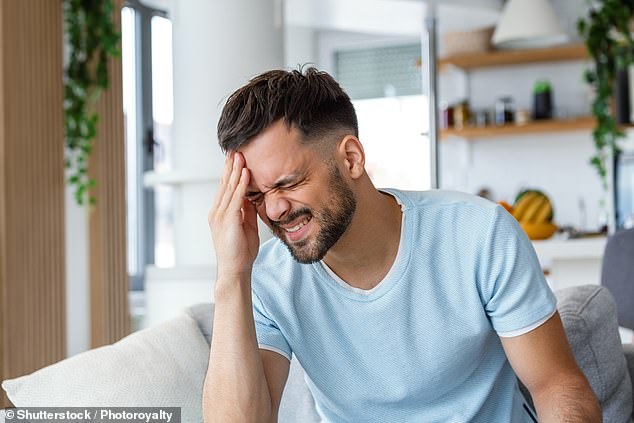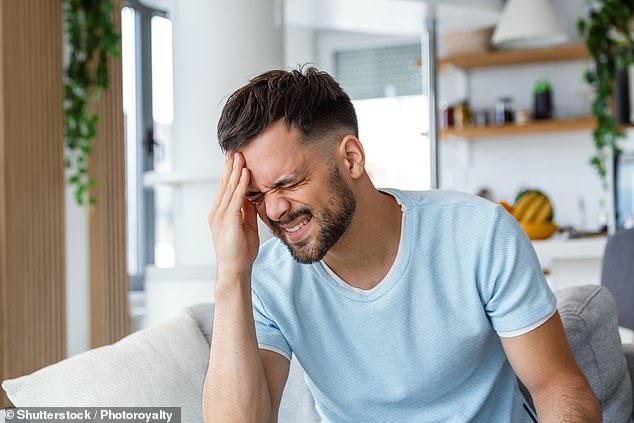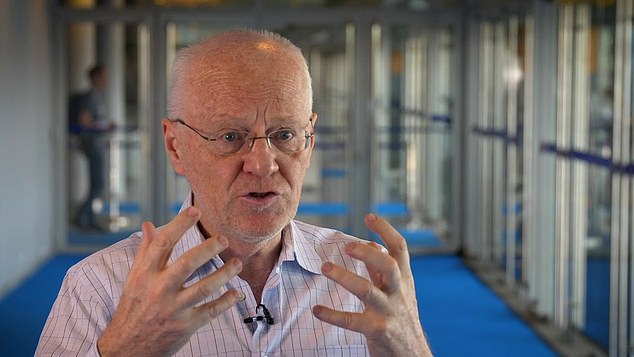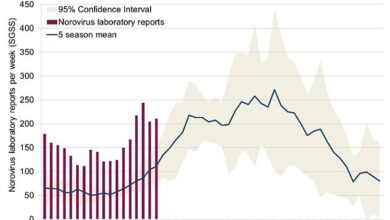Quiz that’ll put an end to headache misery: Top doctors reveal every kind, how to diagnose them and the incredible quick tricks that really will get rid of them fast





A dull ache, a stabbing pain round the eyes, or one-sided throbbing – headaches can take a variety of forms but they affect most of us at some point, and for some people they’re a chronic problem.
Typically this can be as a result of stress, or the effect of bad posture, or dehydration – but in a tiny proportion of cases, they may be a red flag for a serious underlying problem.
If you are getting a lot of headaches, keep a diary noting when they occur, suggests headache specialist Peter Goadsby, a professor of neurology at King’s College London. ‘This can help you identify patterns and key symptoms if they are becoming a persistent problem.’
Once you’ve found the trigger, it can make it easier to choose the right treatment – and it may not be the latest (and more costly) drug that works.
Indeed, a new study from the University of Oxford published in the BMJ found that some of the newer migraine drugs are no more effective than paracetamol – and argued that a cheaper class of medications (called triptans, which cost around £1 a pill) should be made more widely available.
We asked Professor Goadsby and other top headache specialists for their advice on how to diagnose your type of headache, the best ways to treat it – plus their expert tips for a quick fix.

If you are getting a lot of headaches, keep a diary noting when they occur

Neurology Professor Peter Goadsby says the diary will help identify patterns
YOUR HEADACHE FEELS LIKE: A tight band around the head.
COULD BE: A tension or ‘stress’ headache.
OTHER SYMPTOMS: ‘A tension headache feels like someone is putting a band around your head and squeezing it tight,’ says Dr Fayyaz Ahmed, a consultant neurologist at Hull and East Yorkshire Hospital and an ambassador of the Migraine Trust charity.
‘It can be severe but is usually mild and not disabling and people can still function whilst they are having one.’
There is no nausea, sickness or light sensitivity as you might get with migraine but, like migraines, tension headaches can last hours, however – ‘if you’re having headaches for 24 hours a day seven days a week, it’s unlikely to be a tension headache,’ adds Dr Ahmed.
CAUSE: Tension headaches are the most common type of headaches, accounting for more than 90 per cent of cases, says Dr Ahmed.
‘They will have a trigger, such as stress, which causes the muscles attached to the pericranium, the fibrous membrane that covers the surface of the skull, to go into spasm.
‘Pain can be felt at the back of the head, the forehead and temples,’ says Dr Ahmed.
‘Tension headaches can also be caused by hormone rushes and imbalances, such as a flood of the noradrenaline hormone which is released when we are under stress, and dehydration which causes the classic hangover headaches.’
Other triggers include poor posture, lack of exercise, bright sunlight, squinting, eyesight problems, and for some missing meals, and certain smells – although these are more usually migraine triggers, says Dr Ahmed.
TREATMENT: ‘Most tension headaches can be treated with over-the-counter painkillers, such as paracetamol or ibuprofen,’ says Dr Ahmed. ‘But I’d discourage taking one that is combined with caffeine or codeine,’ he says, because these lead to their own withdrawal headaches (where the withdrawal effects of the painkiller brings on a headache.)
Applying a cold compress to the forehead can also ease pain, he says. That’s because there are pain receptors on blood vessels in the head and so pain may occur when these blood vessels dilate. The cold compress restricts the blood vessels, easing the pain.
The cold also relaxes muscular tension as as does ‘applying heat at the back of the head’, adds Dr Ahmed.
‘Lifestyle changes, including learning to relax and managing stress, drinking enough fluids and taking exercise can also help prevent tension headaches as this reduces stress on the body which can cause headaches.’
Other measures that can be beneficial include getting enough sleep and not missing meals, he adds.
‘For chronic tension headaches we may prescribe a low dose of the antidepressant amitriptyline as a preventative. It works by stopping the release of neurotransmitters [chemical messengers] such as noradrenaline and adrenaline, thought to be involved in headache.’
The beta blocker propranolol can have a similar effect, he adds.
YOUR HEADACHE FEELS LIKE: One-sided pain with nausea or visual symptoms.
COULD BE: Migraine.
OTHER SYMPTOMS: ‘Migraines are usually crushing headaches that make you feel sick, but they come in all shapes and sizes,’ says Dr Ben Turner, a consultant neurologist at Barts and the Royal London NHS Trust and the private London Bridge Hospital.
‘My best diagnostic test is to see if a headache stops someone working – with a tension headache you can carry on working but with a migraine you tend to be immobilised and want to lie down in the dark.’
Around a third of migraines will have ‘aura’ symptoms of nausea, fatigue, noise, light sensitivity and visual disturbances which may occur in the run up to or alongside the headache.
Sometimes these aura symptoms occur without the headaches – known as a ‘silent’ migraine.
‘A migraine is usually a headache with some other type of feature,’ adds Dr Jessica Briscoe, a GP and headache specialist at the National Migraine Centre charity in London.
‘Anyone with regular troublesome headaches that are made worse by movement, noise and certain smells such as petrol or perfume usually has migraine,’ she adds.
‘Migraines tend to be under-diagnosed as people dismiss them as headaches and don’t see a doctor about them.’
Other less common symptoms of migraines include abdominal pain, mental fogginess, numbness, pins and needles and sinus pain.
CAUSE: The second most common type of headache, an estimated 11 million people in the UK have regular migraines, and migraine attacks are thought to be experienced by 190,000 people a day in this country. Migraines are much more common in women than men – probably because of the effect of fluctuating hormone levels.
‘We don’t fully understand what causes them, but we think nerves in the head start misfiring – we know it starts in the mid-brain and fans outwards towards the peripheral nerves in the back of the head, neck or shoulders,’ says Dr Briscoe.
‘Genes also play a role as headaches tend to run in families.’
TREATMENT: People who suffer from migraines can be sensitive to changes in their environment or lifestyle so eating, drinking fluids and sleeping at set times can be helpful as a preventative.
Initially migraine attacks can be treated in the same way as tensions headaches, but if those aren’t effective there are other options. These include drugs called triptans, such as sumatriptan (available over the counter) which act on the brain, to effect the action of a chemical messenger called serotonin (some research suggests serotonin can trigger migraine attacks). Triptans won’t prevent a migraine but can halt an attack or reduce symptoms and should be taken at the first signs of a migraine coming on.
Triptans can be taken in combination with painkillers as pills, injections or nasal sprays.
Recent research by the University of Oxford comparing the benefits of 17 different oral migraine medications found that four triptans – eletriptan, rizatriptan, sumatriptan, and zolmitriptan – are the most effective oral treatments (tablets) for stopping migraine pain.
The researchers based their results, published in the BMJ this month, on findings from 137 trials involving 190,000 people.

Dr Kay Kennis, a GP and trustee of The Migraine Trust, says triptans can be helpful to some patients, but not to others

Dr Giorgio Lambru says CGRP drugs have been revolutionary in the fight against migraines
However, Dr Kay Kennis, a GP and trustee of The Migraine Trust, says: ‘While triptans can be very effective for some patients, there are many for whom multiple triptans have been ineffective, caused intolerable side-effects, or in whom triptans are contraindicated [for example those with cardiovascular disease].
‘In individuals who do not respond to triptans, in those who develop side-effects, or in those who can’t have triptans for medical reasons, there should be no barrier to receiving newer rescue therapies provided the national guidelines are followed.’
Newer drugs include calcitonin gene-related peptides (CGRPs) monoclonal antibodies, which target a protein-like compound called CGRP thought to relay pain signals around the brain as well as causing inflammation that may make pain worse. These may be offered to those with chronic migraines who do not respond to other medications.
These come as injections or infusions given every month or every three months and must be prescribed by a specialist.
‘This class of drugs have been revolutionary,’ explains Dr Giorgio Lambru, a consultant neurologist at Guy’s and St Thomas’s Headache service and the private London Bridge Hospital.
‘They have been studied in both chronic and episodic migraine and work in 40 to 60 per cent of cases by significantly reducing symptoms.’
There is however, another newer tablet form of drugs that work against CGRP, called gepants – these bind to a receptor that blocks CGRPs’ effects.
There are two approved for use on the NHS, says Dr Ahmed. ‘Rimegepant may be given for prevention and treatment of an attack and atogepant is purely a preventative.
‘They can be offered to those who had failed at least three first-line treatments.’
Botulinum toxin type A better known as ‘Botox’ has been licensed in the UK since 2012 to treat migraines. Experts are not sure how it works, but it may be offered to patients who have failed on three drug treatments and are having headaches on 15 days a month, eight of which must be migraine. Injections are given every three months.
‘The precise mechanism for how it helps migraines is not fully understood,’ says Dr Lambru. But the latest thinking is that it works by blocking a protein released from nerve endings that’s involved in nerve inflammation and excitability.
Some patients may be offered transcranial magnetic stimulation (TMS) where they self administer a magnetic pulse to the back of the head from a handheld magnetic coil device.
‘TMS is targeted at the back of the brain, the visual cortex which produces images, but also migraine aura,’ explains Dr Lambru. ‘Patients use it two to three times a day to prevent migraine.’
There is limited availability on the NHS.
YOUR HEADACHE FEELS LIKE: Stabbing around the eyes
COULD BE: Cluster headache.
OTHER SYMPTOMS: ‘These are said to be the worst type of headache to affect mankind,’ says Dr Ahmed.
The pain tends to centre around the eyes and brings a sharp, burning, or a piercing sensation on one side. Other symptoms can include red, bloodshot eyes, a droopy eyelid, a sweaty face, flushing and a runny or blocked nose.
‘Those affected definitely don’t want to lie down in a dark room like migraine sufferers do – they want to move around as they feel restless and agitated, they will rock or go out and start digging the garden,’ says Dr Ahmed.
Attacks can last between 15 minutes and three hours and sufferers can get up to eight attacks a day every day for a few weeks to a few months.
CAUSE: These affect an estimated 66,000 people in the UK, and those who have them are very badly affected, says Dr Ahmed.
Cluster headaches tend to run in families and are more common in smokers. Men are more likely to be affected than women at a ratio of almost three to one.
Not much is known about the cause of cluster headaches, but one theory is that they stem from a malfunction in the hypothalamus, the brain’s ‘master clock’ which controls many functions including the sleep-wake cycle.
This may explain why cluster headaches (also called clockwork headaches) tend to occur at certain times of the day and even on certain days in a week. They tend to be more common in spring and autumn.
TREATMENT: ‘Pure oxygen therapy is the best treatment for cluster headaches – the NHS provides a home oxygen service where oxygen in canisters is delivered to you,’ says Dr Ahmed.
‘You inhale the oxygen through a mask during an attack and the pain usually passes within a few minutes.’
Other treatments include sumatriptan via injections or nasal sprays and gammaCore, a handheld device that targets the vagus nerve (used by the patient at home) which carries pain signals between the brain and other organs.
The device is applied to the neck to deliver a small electric current for two minutes at a time. It can be used daily to help prevent cluster headache or when someone feels a cluster headache beginning.
It’s available on the NHS but can only be prescribed by a consultant neurologist and only if other treatments such as oxygen therapy haven’t helped.
YOUR HEADACHE FEELS LIKE: A dull ache that’s worse in the morning
COULD BE: Medication overuse headache.
OTHER SYMPTOMS: A constant, dull headache that feels worse in the morning and may occur every day or part of everyday, and you will have been taking painkillers.
CAUSE: It may sound counter-intuitive, but if you take painkillers for a long period you may develop a medication overuse headache (MOH), where the withdrawal effects of the painkiller wearing off induce a headache.
People who take painkillers two or three times a week or for more than ten days a month are at high risk of developing these headaches.
‘All forms of painkillers if taken more than the recommended days a month can induce a MOH, but medicines containing codeine are worst,’ says Dr Ahmed. ‘Triptans can cause medication overuse headaches too, but are easy to withdraw from.
‘Around 1 to 2 per cent of headaches are caused by medication overuse,’ he explains. ‘It can be a very difficult cycle to break, and patients can be quite resistant to the idea of giving up their painkiller.’
TREATMENT: ‘If you have a medication overuse headache there’s no point taking any other drugs as they won’t work as the withdrawal will always cause a headache,’ says Dr Ahmed.
‘I have to tell people they will get worse before they get better.
‘Stopping abruptly is the best way to do it. People may need to take time off work to adjust.’
YOUR HEADACHE FEELS LIKE: An excruciating bolt from the blue
COULD BE: Thunderclap or ‘sex’ headache.
OTHER SYMPTOMS: These are sudden-onset headaches which are excruciatingly painful, which often coincide with vigorous activity such as exercise or sex.
‘The pain peaks within a minute and feels like you have been hit over the head with a cricket bat and the initial pain is followed by aura symptoms such as nausea and light sensitivity and a stiff neck,’ says Dr Ahmed. ‘They tend to come on with physical activity such as sex, lifting weights or running on a treadmill.’
CAUSE: While the cause is generally unknown, in one in eight cases this could be a sign of a bleed on the brain, says Dr Ahmed.
Treatment: ‘If you experience these symptoms, you should go straight to A&E,’ he says. ‘There is no way of knowing from symptoms alone, so you need to have a CT scan and a lumbar puncture (spinal tap). ‘Don’t try and treat this yourself, get checked out’
YOUR HEADACHE CAUSES PAIN WHEN YOU STAND UP
COULD BE: Postural headaches.
OTHER SYMPTOMS: The pain is most severe at the back of the head and worsens throughout the day.
These types of headache occur when you switch position, and sometimes occur with a racing heart.
CAUSES: Switching position causes a change in blood pressure in the head, creating a headache.
These can also occur due to postural orthostatic tachycardia syndrome (PoTS) which triggers a rapid heartbeat and change in blood pressure when you stand up. That’s because the autonomic nervous system which regulates bodily functions including blood pressure doesn’t work properly, causing a drop in blood supply to the brain and head pain.
Other possible – more serious – causes include a leak of cerebrospinal fluid from the spinal cord.
TREATMENT: Simply closing your mouth and pinching your nose while bearing down (as when you go to the loo) can restore blood pressure, says Dr Briscoe.
But you should see doctor and ask for your symptoms to be investigated if it happens regularly.
A tilt-table test can diagnose PoTS. The patient is strapped to a table while attached to an ECG to measure their heart’s electrical activity and a blood pressure monitor and tilted to a 60 to 90-degree angle.
PoTS can be treated with beta blockers and selective serotonin reuptake inhibitors (SSRI) antidepressants.
IF YOUR HEADACHES FEELS LIKE: Throbbing in the temples
COULD BE: Temporal arteritis headache.
OTHER SYMPTOMS: As well as aching in the temples, those affected may have a loss of appetite, unexplained weight loss (because temporal arteritis is an inflammatory condition and most people with any such condition will lose weight and appetite) and jaw pain. Pain and tenderess at the side of the head, temples, or on the scalp, jaw pain, vision problems.
CAUSE: ‘These types of headaches are caused by inflammation of the arteries in the head, the arteries can become swollen and blocked,’ say Dr Ahmed.
‘If left untreated this can lead to a stroke or blindness. The headache may present with pain in the jaw during eating (jaw claudication) and fever, loss of appetite and insomnia.’
‘It’s more common in patients above the age of 60 and hence any new onset of headache over this age must be investigated on these lines,’ says Dr Ahmed.
Tests should include routine blood tests for inflammatory markers.
TREATMENT: High-dose steroids to treat the inflammation. ‘The response is dramatic, and the patients will feel a lot better within 24 to 28 hours,’ says Dr Ahmed. The dose is gradually reduced after the first few weeks.
Do you really need those expensive special ‘headache’ pills?
Pharmacies now sell specific headache remedies – usually at least three times the price of standard painkillers. They’re convenient, but do they work as well?
Combination pills (such as Migraleve Pink £9.99 for 24) for instance contain 8mg codeine phosphate and 520mg paracetamol with 6.25mg Bulizine phosphate, an anti-sickness drug.
‘Drugs which combine paracetamol and codeine painkillers are not great for migraine,’ says Paul Booton, a retired GP and former professor of general practice at St George’s Hospital, London, and an adviser to the National Migraine Centre.
‘They contain codeine which doesn’t work for migraine pain and can make nausea and sickness worse and is also more likely to result in medication overuse headaches. Paracetamol is not as effective as non-steroidal anti-inflammatories [NSAIDS – such as aspirin or ibuprofen] and can make nausea and sickness worse and is also more likely to result in medication overuse headaches.’
However, community pharmacist Sultan Dajani points out that the all-in-one migraine product Migraleve is popular with migraine sufferers as it’s the only over the counter product that contains an anti-nausea drug with a painkiller.
‘If you’re on a tight budget though, you can save yourself a lot of money by buying generic painkillers and getting a prescription for anti-sickness drugs from your GP,’ he says.
Peter Goadsby, a professor of neurology King’s College says there is no substantial evidence that painkillers marketed specifically as headache pain relievers are any better than standard painkillers. ‘What is important is the dose. Some of them are faster-acting, but the time difference will be only about 15 to 30 minutes.’
Quick fixes from the experts
• For a quicker pain fix dissolve soluble aspirin in a fizzy caffeinated drink says Dr Jessica Briscoe, a GP and headache specialist at the National Migraine Centre charity in London.
‘The bubbles from the fizzy drink will increase the surface area of the active ingredients and get them into your bloodstream quicker and the caffeine may improve the effectiveness of the aspirin.’
• Hit a migraine hard with the maximum recommended painkiller dose as early as possible: ‘If you feel a migraine coming on it’s important you take the right painkiller at the right dose at the right time,’ advises Professor Paul Booton, a retired GP and adviser with the National Migraine Centre, who is himself a migraine sufferer. ‘Around a third of migraine sufferers get warning symptoms up to 24 hours before a migraine starts such as excessive tiredness or sometimes euphoria and this is the ideal time to take painkillers. Take a non-steroidal anti-inflammatory drug, such as three 300mg aspirin tablets (a combined dose of 900mg) or three 200mg ibuprofen tablets (combined dose of 600mg), and a prescription-only anti-sickness drug such as domperidone at a dose of 10mg.
• Drink coffee but only if you don’t normally drink much. ‘Caffeine has some painkilling properties,’ says Dr Giorgio Lambru, lead neurologist at Guys and St Thomas’s Headache Centre in London. ‘Strong coffee can improve headache pain if used once in a while – this applies to tea and Red Bull as well. However, if you generally drink a lot of caffeine, a caffeinated drink can make it worse and causes a rebound headache at weekends when you drink less of it.’
• Avoid taking codeine if you get migraines ‘as it means you are less likely to respond to triptan drugs for a month afterwards,’ says Professor Goadsby.
Red-flag signs your headache could be more serious
Seek urgent medical attention if:
• You have had a headache following a head injury – for example, from a fall or accident.
• You have a headache that came on very suddenly and is extremely painful.
• You have an extremely painful headache and sudden problems speaking or remembering things or loss of vision, feel drowsy or confused or the white part of the eye is red or you have a very high temperature and symptoms of meningitis (such as pale, mottled or blotchy skin).




